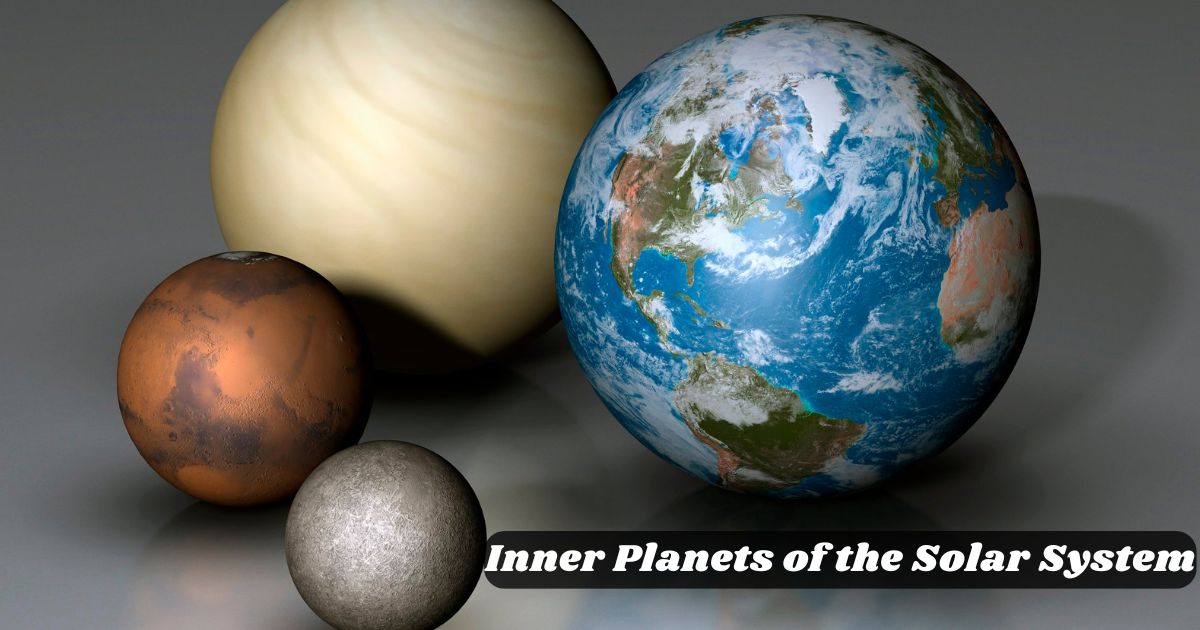Introduction
The solar system is domestic to numerous fascinating celestial bodies, and among them, the inner planets hold a extraordinary place. These planets, found closest to the Sun, are special in their characteristics and offer profitable insights into workings of our solar neighborhood. In this blog post, we will investigate inner planets system: Mercury, Venus, Earth, Mars.
Table for Inner Planets of the Solar System
| Planet |
Size |
Atmosphere |
Surface Features |
Potential for Life |
| Mercury |
Smallest |
Very thin, almost none |
Cratered, rocky |
No potential for life |
| Venus |
Similar to Earth |
Thick, mostly CO₂ |
Volcanic plains, high surface pressure |
Unlikely due to extreme conditions |
| Earth |
Largest of the inner planets |
Rich in oxygen and nitrogen |
Oceans, diverse landscapes |
Supports life |
| Mars |
About half the size of Earth |
Thin, mostly CO₂ |
Largest volcano, canyons |
Possible past microbial life |
Key Takeaways
- The inner planets are Mercury, Venus, Earth, and Mars.
- Mercury is the littlest planet with extraordinary temperature variations.
- Venus is Earth’s twin but has a scorching, uninhabitable atmosphere.
- Earth is the only planet known to support life.
- Mars, the Red Planet, has potential signs of ancient life.
- Inner planets have rough surfaces and dense metal cores.
- Venus’s greenhouse impact makes it the hottest planet.
- Mars is currently being investigated for evidence of past life.
- Earth’s magnetosphere secures it from harmful space radiation.
- Future missions will continue to investigate the inner planets.
What Are the Inner Planets?
The internal planets, otherwise called earthly planets, are the four planets nearest to the Sun. They are classified “earthbound” in light of the fact that they have solid, harsh surfaces. These planets Mercury, Venus, Earth, and Mars. Not at all like outer planets, which gas goliaths, inward thick metal centers unpleasant hulls. Their area to the Sun gives them certain unique attributes, for example, more limited orbital periods and somewhat higher temperatures contrasted with the external planets.
Mercury: The Smallest and Closest to the Sun
Physical Characteristics and Composition
Mercury is the littlest planet in nearby group and nearest one to Sun. It just marginally bigger than Earth’s Moon. Mercury has a thin atmosphere made up mostly of oxygen, sodium, hydrogen. Since it so near Sun, encounters outrageous temperature vacillations. During the day, temperatures can take off to around 430°C (800°F), while around evening time, they can drop to – 180°C (- 290°F).
Surface Features and Geological Activity
The outer layer of Mercury is covered with cavities, similar as our Moon. These pits were shaped by influences from space rocks and comets. Mercury has an enormous iron center, which takes up around 85% of the planet’s span. Researchers accept that this center creates an attractive field, however it is a lot more vulnerable than Earth’s.
Investigation and Missions to Mercury
Regardless of its nearness to the Sun, Mercury has been visited by spacecraft. NASA’s Courier mission circled Mercury from 2011 to 2015, giving important information about its surface, environment, and attractive field. Another mission, BepiColombo, sent off by the European Space Organization and Japan Aviation Investigation Office, is at present while heading to concentrate on Mercury more meticulously.
Venus: Earth’s Twin with a Hellish Climate
Similarities and Differences with Earth
Venus is in many cases called Earth’s twin since it is comparable in size, mass, and creation. Nonetheless, the similitudes end there. Venus has a thick climate made basically out of carbon dioxide, with billows of sulfuric corrosive. This climate traps heat, prompting an out of control nursery impact that makes Venus the most blazing planet in the planetary group, with surface temperatures coming to 465°C (869°F).
Surface and Climatic Conditions
The outer layer of Venus is an unfriendly climate. The thick climate makes huge tension, multiple times that of Earth’s adrift level, which is comparable to the strain tracked down 900 meters (3,000 feet) submerged on The planet. The surface is for the most part smooth, for certain mountains and huge volcanic fields. There is no fluid water on Venus, and its outrageous circumstances make it a far-fetched possibility for life as far as we might be concerned.
Exploration and Discoveries about Venus
Venus has been investigated by a few spascrafts. The Soviet Association’s Venera program effectively handled various tests on the outer layer of Venus, giving the primary pictures from the surface. NASA’s Magellan mission during the 1990s planned the planet’s surface with radar, uncovering subtleties of its geology. As of late, interest in Venus has reignited, and new missions, similar to NASA’s VERITAS and ESA’s Imagine, are wanted to investigate Venus further.
Earth: The Life-Supporting inner Planet

Earth: The Life-Supporting inner Planet
Remarkable Highlights that Help Life
Earth is the main planet known to help life. A few elements add to this, including its ideal separation from the Sun, a steady environment, and a defensive climate. Earth’s air is comprised of nitrogen, oxygen, and different gases that give the air we inhale and shield us from destructive sun oriented radiation.
Land Movement and Surface Features
Earth’s surface is dynamic, with structural plates that move and shape the scene. This geographical action makes mountains, quakes, and volcanic emissions, all of which play had an impact in molding the planet’s surface. Earth’s surface is 71% water, which is pivotal forever. The seas manage temperature and give a living space to incalculable species.
Importance of Earth’s Magnetosphere
Earth is also protected by a magnetic field, known as the magnetosphere, which shields planet from harmful solar wind and cosmic radiation. This field generated movement of molten iron in Earth’s outer core. Without it, life on Earth would be exposed to deadly radiation space.
Mars: The Red Planet with Potential for Life
Physical Characteristics and Composition
Mars, frequently called the Red Planet due to its reddish appearance, is the fourth planet from the Sun. It is about a portion of the size of Earth and has a dainty air made generally out of carbon dioxide. Mars has the biggest well of lava in the planetary group, Olympus Mons, and a ravine framework, Valles Marineris, that dwarfs the Grand Canyon.
Proof of Water and Potential for Life
Mars has for quite some time been a focal point of interest in the quest for life past Earth. Proof recommends that fluid water once streamed on Mars, and there might in any case be water ice underneath its surface. The presence of water is a critical figure the potential forever, and researchers keep on concentrating on Mars to decide whether it at any point upheld microbial life.
Current and Future Mars Missions
Mars has been broadly investigated by orbiters, landers, and meanderers. NASA’s Determination meanderer, which arrived in 2021, is right now looking for indications of antiquated life and gathering tests for future re-visitation of Earth. Future missions, for example, the Mars Test Return and expected human missions to Mars, intend to extend how we might interpret the Red Planet.
Comparative Analysis of the Inner Planets
Similarities Among the Inner Planets
Theinner planets share a few likenesses, for example, their rough sytheses and generally little sizes contrasted with the external planets. They all have strong surfaces with differing levels of land movement. Every one of these planets has an iron-rich center, however the size and condition of these centers change.
Contrasts in Environments, Surfaces, and Potential for Life
Notwithstanding their likenesses, the internal planets additionally have huge contrasts. Mercury has for all intents and purposes no atmosphere, while Venus has a thick, poisonous one. Earth’s environment upholds life, and Mars’ slender air is for the most part carbon dioxide. Surface circumstances likewise differ significantly, with Earth being the main planet with fluid water and a steady environment helpful for life.
Difficulties and Future Investigation of the inner Planets
Innovative and Natural Challenges
Investigating the inner planets presents huge difficulties. Mercury’s closeness to the Sun makes it hard to reach and get by. Venus’ outrageous intensity and strain require cutting edge innovation to investigate. Mars, while additional open, actually presents difficulties because of its meager environment and brutal surface circumstances.
Planned and Proposed Missions to Inner Planets
Future missions to the internal planets are now in the arranging stages.
NASA’s Artemis program plans to return people the Moon, preparing for future missions Mars. The European Space Organization’s Imagine mission will concentrate on Venus, and arranged keep investigating Mars, with objective of ultimately sending Red Planet.
FAQs About Inner Planets of the Solar System
1. What makes the internal planets unique in relation to the external planets?
The internal planets are more modest, have strong, rough surfaces, and are nearer to the Sun, while the external planets are bigger, for the most part made out of gas, and found farther from the Sun.
2. Why is Venus more sizzling than Mercury regardless of being farther from the Sun?
Venus has a thick climate loaded up with carbon dioxide, causing major areas of strength for an impact that traps heat, making it the most smoking planet in the planetary group.
3. Can life exist on Mars?
While Mars has proof of past water and conditions that might have upheld microbial life, there is as of now no authoritative confirmation of life on Mars.
4. Why does Mercury have outrageous temperature fluctuations?
Mercury has an exceptionally slight air that can’t hold heat, causing very hot temperatures during the day and frigid temperatures around evening time.
5. How earths’ attractive field safeguard life?
Earth’s attractive field safeguards the planet from destructive sunlight based breeze and inestimable radiation, making it feasible for life to flourish with the surface.
Conclusion
The internal planets of the planetary group offer an abundance of information about the development and advancement of planets. From Mercury’s cratered surface to Venus’ thick air, Earth’s life-supporting climate, and Mars’ true capacity for previous existence, every planet gives one of a kind bits of knowledge. As innovation propels, future investigation will keep on opening the secrets of these captivating universes, carrying us nearer to figuring out our position in the nearby planet group.


